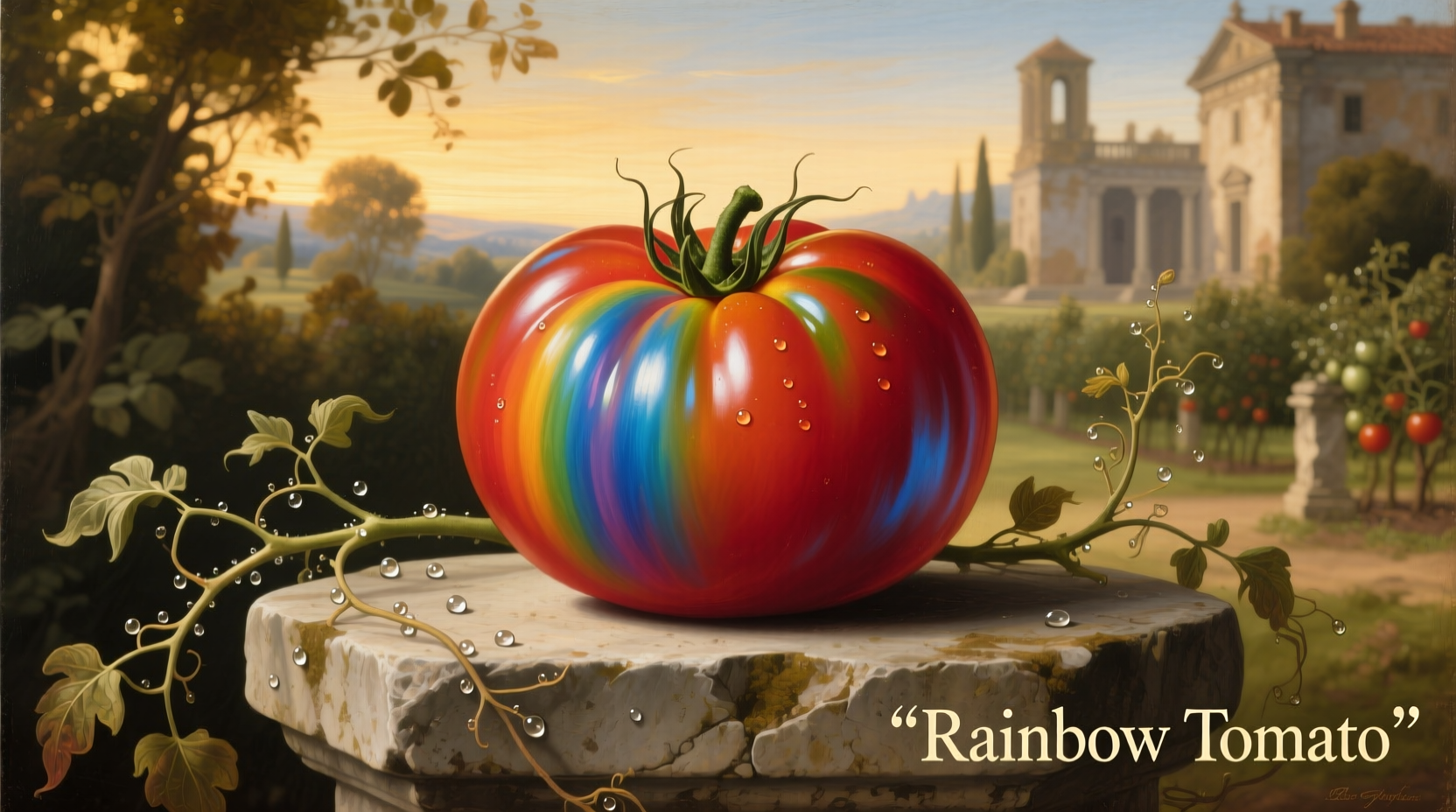What Makes Rainbow Tomatoes Different From Ordinary Tomatoes?
Unlike the uniform red tomatoes dominating supermarket shelves, rainbow tomatoes represent a diverse family of heirloom varieties celebrated for their stunning visual appeal and complex flavor profiles. These aren't genetically engineered creations but the result of careful selective breeding over generations. The vibrant color variations come from natural pigments that also contribute to their nutritional advantages.
Many gardeners and chefs mistakenly believe "rainbow tomato" refers to a specific cultivar. In reality, it's a descriptive term for numerous heirloom varieties including Green Zebra, Black Krim, German Green, Yellow Pear, and Indigo Rose—each with distinctive color patterns and flavor characteristics. Understanding this distinction helps consumers appreciate the biodiversity these tomatoes represent.

Understanding the Color Spectrum: A Scientific Perspective
The remarkable colors in rainbow tomatoes stem from different phytonutrients developed through natural breeding. These pigments aren't merely decorative—they signal varying nutritional profiles that benefit human health. Unlike standard red tomatoes that primarily contain lycopene, rainbow varieties offer a broader spectrum of beneficial compounds.
| Color Variation | Primary Pigments | Nutritional Benefits | Common Varieties |
|---|---|---|---|
| Red-Orange | Lycopene, Beta-carotene | Heart health, antioxidant protection | Brandywine, Cherokee Purple |
| Yellow-Gold | Beta-carotene, Xanthophylls | Vitamin A precursor, eye health | Golden Sunray, Lemon Boy |
| Green-Striped | Chlorophyll, Flavonoids | Detoxification support, anti-inflammatory | Green Zebra, German Green |
| Purple-Black | Anthocyanins, Lycopene | Brain health, cardiovascular protection | Indigo Rose, Black Krim |
Flavor Profiles Across the Rainbow
Color variations in rainbow tomatoes directly correlate with distinctive taste experiences. The pigments influencing their appearance also affect sugar-acid balance and aromatic compounds:
- Red varieties typically offer classic tomato sweetness with balanced acidity
- Yellow and orange types generally have lower acidity and higher sugar content, creating a sweeter profile
- Green heirlooms maintain firm texture with complex, sometimes citrusy notes even when ripe
- Purple and black tomatoes develop earthy, smoky undertones alongside their natural sweetness
Professional chefs like Maya Gonzalez note that "the color spectrum in heirloom tomatoes translates directly to flavor diversity. A salad combining multiple rainbow varieties creates a symphony of tastes that single-color tomatoes simply can't match." This flavor diversity makes rainbow tomatoes particularly valuable for culinary applications where complexity matters.
Practical Growing Guide for Home Gardeners
Growing rainbow tomatoes successfully requires understanding their specific needs. Unlike commercial hybrid varieties bred for uniformity and shipping durability, heirloom rainbow tomatoes often have more particular requirements:
Essential Growing Conditions
- Sunlight: Minimum 6-8 hours of direct sun daily (purple varieties need more sun for optimal anthocyanin development)
- Soil: Well-draining, slightly acidic soil (pH 6.2-6.8) enriched with organic matter
- Watering: Consistent moisture (1-2 inches weekly), avoiding leaf contact to prevent disease
- Support: Sturdy cages or trellises as many heirloom varieties produce heavy fruit
Top Rainbow Varieties for Beginners
For gardeners new to heirloom tomatoes, these varieties offer reliable results with distinctive rainbow characteristics:
- Green Zebra: Striking green-yellow stripes, tangy flavor, matures in 75 days
- Black Cherry: Deep purple-red fruit, sweet complex flavor, excellent for containers
- Pineapple: Yellow-orange with red marbling, tropical-sweet taste, large beefsteak size
- Yellow Pear: Tiny yellow fruits, exceptionally sweet, perfect for salads
Nutritional Advantages Backed by Research
Multiple studies confirm that the diverse pigments in rainbow tomatoes translate to enhanced nutritional profiles. Research from the USDA Agricultural Research Service shows that anthocyanin-rich purple tomatoes contain up to 10 times more antioxidants than standard red varieties. A 2023 study published in the Journal of Agricultural and Food Chemistry demonstrated that multi-colored heirloom tomatoes provide a broader spectrum of beneficial phytonutrients compared to single-color varieties.
The USDA's phytochemical database confirms that different tomato colors contain unique combinations of health-promoting compounds. For example, green-ripe varieties maintain higher chlorophyll content which shows potential anti-mutagenic properties, while purple varieties deliver anthocyanins associated with improved cognitive function.
Where to Find and How to Select Rainbow Tomatoes
Finding authentic rainbow heirloom tomatoes requires knowing where to look and what to look for:
Best Sources
- Local farmers markets: Peak availability from July through September
- CSA programs: Many specialty vegetable CSAs feature heirloom tomato varieties
- Specialty grocers: Stores focusing on local or organic produce
- Growing your own: Most reliable way to access diverse rainbow varieties
Selection Tips
When choosing rainbow tomatoes, look for:
- Fruit that feels heavy for its size (indicates juiciness)
- Smooth, unblemished skin appropriate to the variety
- Vibrant color patterns characteristic of the specific variety
- A sweet, earthy aroma at the stem end
- Slight give when gently squeezed (avoid overly soft spots)
Remember that some varieties like Green Zebra remain green when ripe, while others like Cherokee Purple develop their characteristic coloration only when fully mature. Researching specific varieties before purchasing prevents disappointment.
Maximizing Flavor in the Kitchen
Rainbow tomatoes shine when prepared in ways that highlight their unique characteristics:
- Raw applications: Create visually stunning salads with multiple color varieties
- Roasting: Concentrates flavors and enhances natural sweetness, especially for yellow varieties
- Sauces: Blend different colors for complex flavor profiles (avoid mixing strong-flavored purple varieties with delicate yellow types)
- Preserving: Water-bath canning works well for most varieties, though purple tomatoes may lose some color intensity
Chef Maya Gonzalez recommends, "When working with rainbow tomatoes, consider their individual characteristics. Pair mild yellow varieties with bold flavors like basil and garlic, while using intensely flavored purple tomatoes as the star ingredient in simple preparations." This approach ensures each variety's unique qualities shine through.











 浙公网安备
33010002000092号
浙公网安备
33010002000092号 浙B2-20120091-4
浙B2-20120091-4